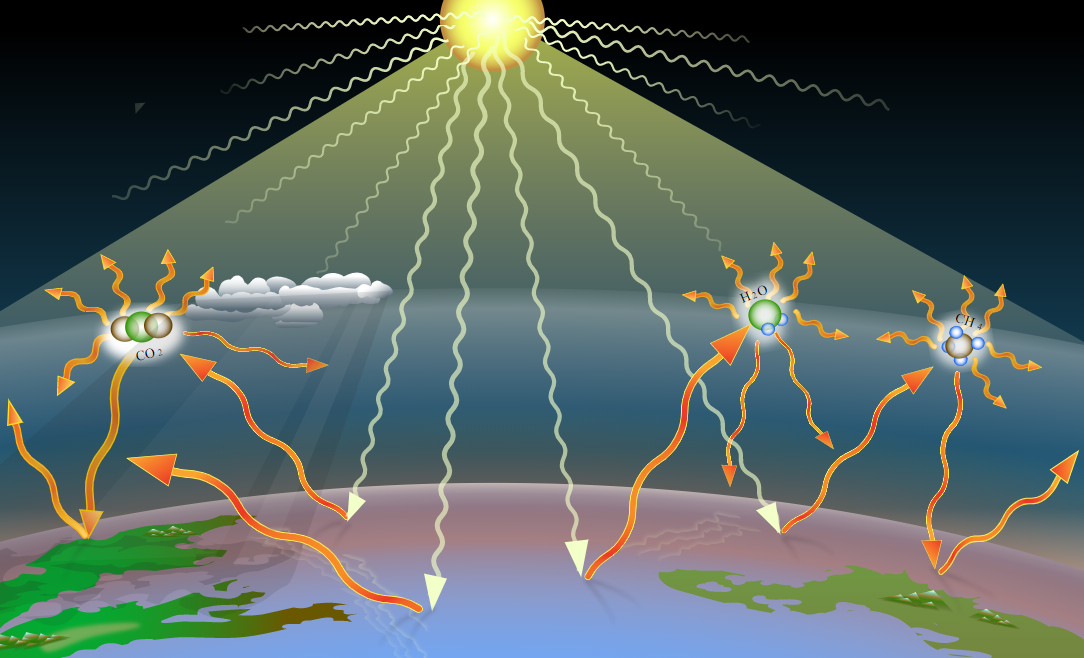
What are greenhouse gases and how is their emission reduced?
What are greenhouse gases?
Greenhouse gases are gases which when released to the atmosphere, block part of the heat of solar origin that Earth re-radiates into space.
What gases promote the greenhouse effect?
There are many greenhouse gases and their properties vary widely. They share a physicochemical structure that enables the molecules to retain heat. The most common greenhouse gases in the atmosphere are:
- water vapour (H2O),
- carbon dioxide (CO2),
- methane (CH4),
- nitrous oxide (N2O),
- chlorofluorocarbons (CFCs).
What is the role of greenhouse gases?
Greenhouse gases are fundamental for the existence of life on planet Earth. The greenhouse effect due to these gases stops the temperature of Earth from falling to very low values. Without them, Earth would have an average annual temperature of -18°C (https://www.oce.global/en/resources/climate-science/ipcc-special-report-global-warming-15degc-summary-teachers). The term greenhouse effect was coined to evoke what happens in greenhouses. The presence of a barrier that can retain part of the solar radiation, preventing all of it from being reflected back into space (or the atmosphere) allows the temperature inside the greenhouse to remain sufficient for plant growth, including vegetables and fruits, in cold climates or cold winters. The barrier of greenhouses is made of plastic, whereas that of Earth consists of these particular gases in the atmosphere.
What is the relation between greenhouse gases and global heating?
The increase in atmospheric concentrations of greenhouse gases, due largely to the combustion of fossil fuels, retains increasing quantities of heat in the atmosphere. This tends to modify and trigger different complex atmospheric phenomena: heat waves, massive evaporation and movements of water causing droughts and floods, increasingly frequent and extreme hurricanes and even abnormal cold spells. For several decades, the term climate change (and now climate crisis) has therefore been preferred to the term global warming.
What human activities produce greenhouse gases?
Human activities responsible for emissions of greenhouse gases at world level are:
- energy production (about 73%),
- agriculture (about 18%),
- waste management (about 5%),
- cement production (about 3%),
- the chemical industry (about 2%).
(https://ourworldindata.org/ghg-emissions-by-sector)
What countries emit the greatest amounts of greenhouse gases?
In terms of total quantity of CO2 produced on national territory, the countries with the highest emissions include industrialised countries with high populations, such as China, United States of America, India, Russia and the European Union. However, in terms of emission per head of population, the countries with the highest per capita emissions are those with high living standards, i.e. high energy consumption, or those whose national energy production relies heavily on fossil fuels. These countries include those of the Persian Gulf (Qatar, Kuwait, Bahrain and United Arab Emirates), Australia, USA, Luxembourg and Canada. (https://folk.universitetetioslo.no/roberan/GCB2020.shtml)
How can emissions of greenhouse gases be reduced?
A reduction in greenhouse gas emissions must involve the economic sectors that produce them in abundance. The transition from a linear economy based on consumption of fossil fuels to a circular economy based on exploitation of renewable resources is a necessary condition for reducing global emissions of greenhouse gases. An agricultural transition is also necessary. An effective measure could be to eat less animal protein and more plant protein.
The current situation of governments regarding greenhouse gas emissions
There have been various international agreements about reducing global emissions of greenhouse gases. Among them, the Kyoto Protocol, which is voluntary, was signed in 1997 during the Conference of the Parties in Kyoto (COP3) but did not come into force until 16th February 2005. At the more recent COP21 (2015), the Paris Agreement, a global framework for avoiding dangerous climate change, aiming to limit the increase in mean annual global temperature to less than +2 C° with respect to 1990, and hopefully even to only +1.5 C°, was signed. The Paris Agreement is the first universal legally binding agreement on climate change and came into force in 2016.
What people can do in everyday life to reduce greenhouse gas emissions good practices for citizens and firms
There is no simple recipe for everyone. Efforts are needed from public bodies, firms and citizens. We certainly need to change some of our habits in the transport sector, favouring public over private transport. We also need to acquire awareness about how goods are produced and how they are treated when we discard them. A simple rule to reduce emissions of greenhouse gases is to avoid waste: waste of energy, food, water and natural resources. Responsible choices are necessary when purchasing a product, whether food, stationery or cleaning products, avoiding single use products and preferring products that can be re-used, including an appraisal of the quantity and type of packaging. Clearly firms must also do the same upstream, avoiding waste, production surplus, packaging and consumption of primary materials, and also considering the end-of-life phase of the product.


